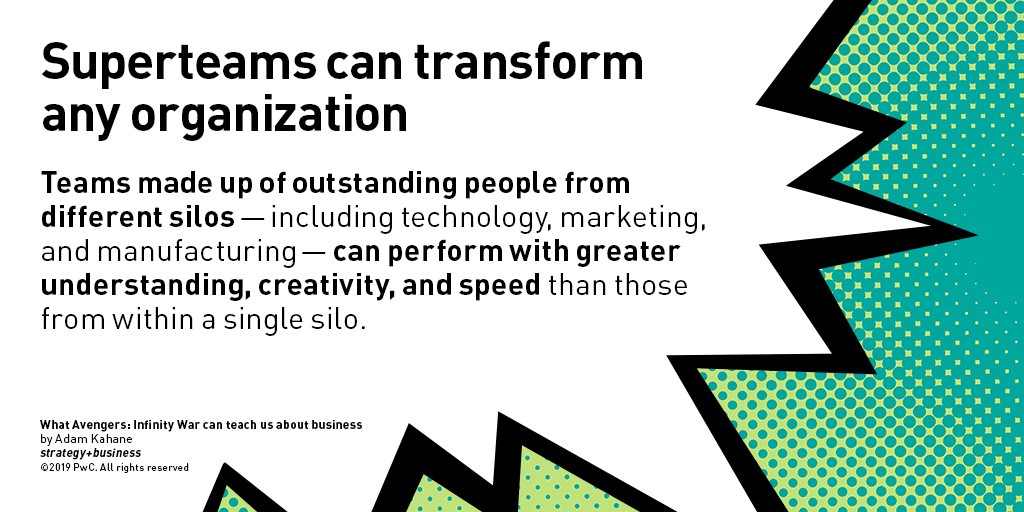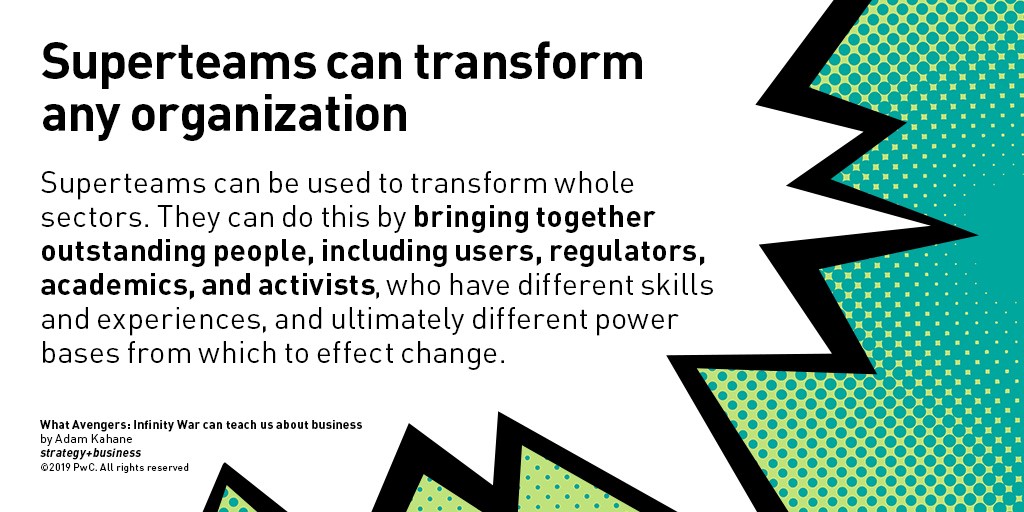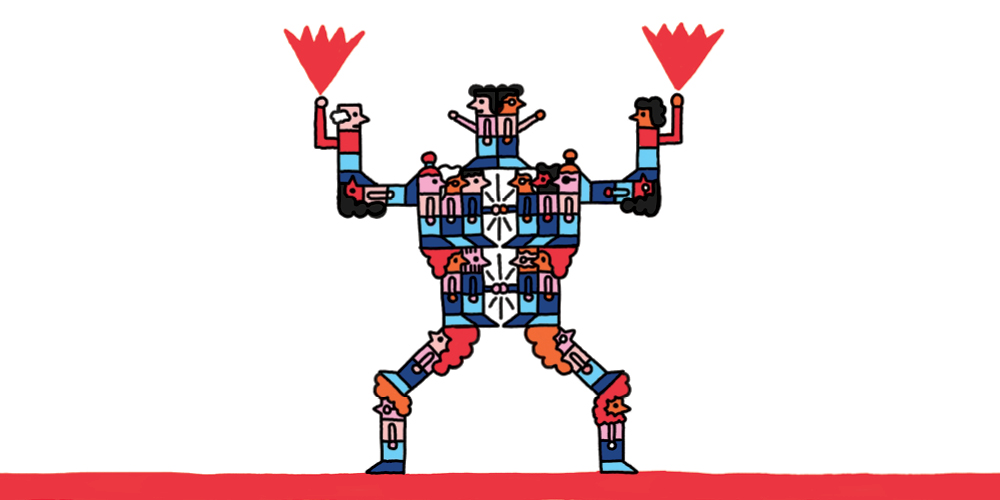What Avengers: Infinity War can teach us about business
The movie shows that diverse individuals can work together to overcome extraordinarily daunting challenges.
A version of this article appeared in the Spring 2020 issue of strategy+business.
What does a movie about a team of superheroes — scientists, soldiers, magicians, monsters, androids, and aliens — who collaborate to try to stop the destruction of half of all life in the universe have to do with business? I didn’t expect to see a connection, but when I watched Avengers: Infinity War, I found it was like watching a dramatized version of my daily working life. My colleagues and I help teams of committed leaders — businesspeople, politicians, civil servants, trade unionists, journalists, activists, academics, and artists — collaborate to address their most important and difficult challenges. The movie helped me see more clearly some of the central dynamics in such efforts.
For example, our work with the Mexico Education Lab has several crucial parallels to the movie. Mexico needs to improve its education system to meet the needs of its diverse population and its developing economy. High school graduation rates and test scores are low, and conflict among education authorities, teachers unions, and civil society organizations is high. Successive governments have attempted ambitious reforms, but these reforms have often been reversed when new administrations have come to power.
The Education Lab is an effort to address these complex challenges in a new way. Fifty leaders from across the system — including federal and state ministers of education and other government officials, teachers union and parents association leaders, politicians, principals, teachers, entrepreneurs, academics, and activists — have been working together for a year. Their objective is not just to meet and talk but to act together to transform the system.
Thinking about the challenging work we’ve been doing in the Education Lab, here are some lessons I think the Avengers movie offers. Be warned: There are spoilers.
A superteam to the rescue
The movie starts with the villainous warlord Thanos determined to obtain six Infinity Stones that will give him the power to control the universe. Already in possession of the first stone, he forces Thor, king of Asgard, to turn over the second. Bruce Banner (alter ego of the monster Hulk) recruits magician Stephen Strange and Tony Stark (Iron Man) to join forces to prevent Thanos from getting the other stones. Banner asks Stark to call Steve Rogers (Captain America), but Stark hesitates. “It’s not that easy.… Captain America and I fell out. We’re not on speaking terms,” Stark says.
Banner replies, “Tony, listen to me.… Thanos is coming. It doesn’t matter who you’re talking to or not.”
This initial group then recruits others: Peter Parker (Spider-Man), Peter Quill, and members of Steve Rogers’s rival faction. They all have their own history, superpowers, and idiosyncrasies. But they agree to join this superteam, despite their differences, because all of them are needed if they are to stop Thanos.
The Education Lab has, similarly, put together nine superteams made up of people with complementary, powerful capacities — including some who up until now haven’t been talking — who can achieve their ambitious objectives only if they collaborate. Each of these teams is working at a different leverage point in the education system, in which a small change has the potential to make a big impact.


One team, trying to scale up early childhood development programs, includes a seasoned researcher and campaigner, one politician with experience in public health programs and another who has shepherded an enabling law through Congress, and a technology expert with connections to a state government where the team is piloting its strategy. A second team, working on introducing new learning methodologies using technology to reach marginalized communities, includes an indigenous leader with the childhood experience of such marginalization, an education entrepreneur whose understanding of what is needed was shaken up by hearing this leader’s story, a hard-driving education ministry project manager, a school principal, and a philanthropist. And a third team, working on changing the way resources are allocated to schools, includes two senior officials from the education ministry, a congresswoman, and an educational policy expert, who together have been able to identify precisely where and when to change the rules that govern resource allocation.
These teams, and the six other teams involved, are powerful specifically because they include diverse and remarkable actors who have never had the opportunity to join forces.
Making hard choices
Many of the most gripping scenes in the movie are those in which the superheroes need to decide what they are willing to do to advance their team’s mission of defeating Thanos. Should Thor sacrifice his brother? Should Peter Quill kill his girlfriend Gamora, as she asked him to do? Should Vision give up his own life? Even Thanos struggles with whether he must kill Gamora, his adopted daughter, to accomplish his mission of obtaining the stones.
Struggling with difficult choices is intrinsic to all collaborations. Is this a battle that I am willing to join, and in so doing, depart from my familiar way of working? Am I willing to team up with these different others, including those I don’t agree with, like, or trust? In order to achieve our mission, am I willing to compromise on something that really matters to me, or even to be seen as a traitor? Collaborating does not involve a single choice — whether to join a team — but a series of them.
Everyone in the Education Lab faces these questions and has to decide, over and over, whether to keep showing up for the project. Each member of each project team has a different type of contribution to make and has different availability, working styles, access to resources, and freedom to maneuver. The project team leaders, who have no actual authority over their members, have struggled to keep their teams together and moving forward. Those who have been most successful have been able to harness and steer the diverse voluntary energies of their team members to achieve the big goals that none of them would be able to achieve alone.
The inner struggle is real
For the Avengers to overcome Thanos, they must overcome their own hesitations, weaknesses, and emotions. This inner struggle is most visible in Bruce Banner, who for most of the movie is unable to transform himself into Hulk, whose superhuman strength the team needs.
So it is for the members of the Education Lab. The system transformation projects they are trying to implement are ambitious, but their biggest challenges lie within themselves: their ability to pay attention, listen to feedback, work with others, and act, pivot, and act again. At the end of their first year working together, one education ministry official said: “I entered this lab believing that I was flexible and open and able to get to agreements. But I have found that I wasn’t as good as I thought I was, and that for us to make progress I needed to change.”
Continuing the fight
Over and over, the Avengers battle Thanos with great teamwork. But in the end, he overwhelms them and destroys half of all life in the universe, including many of the Avengers. The others live to fight another day.
Superteams can be used to transform any organization. Outstanding people from different silos can perform with greater understanding, creativity, speed, and reach than those from within a single silo.
The Mexican education system is dynamically complex, meaning cause and effect are far apart in both space and time. Changing this system requires a systemic approach. It is generatively complex, meaning the future is unfamiliar and unpredictable, and so requires an experimental approach. And it is socially complex, meaning different stakeholders have different perspectives and interests, and so requires a collaborative approach. There is no quick or easy way to transform such a system.
The accomplishments of the project teams so far are uneven and tentative. Some of them are more advanced than others, and as a whole they are a long way from effecting transformation. They may fail — many previous efforts have. But they are continuing to fight hard, together, because they believe that together their chances are better.
Superteams like those working in the Education Lab can be used to transform any organization. Whether at the project level or executive level, teams made up of outstanding people from different silos — including technology, finance, marketing, manufacturing, and communications — can perform with greater understanding, creativity, speed, and reach than those from within a single silo. And on a larger scale, superteams can be used to transform whole sectors, such as education. They can do this by bringing together outstanding people from across organizations, including companies in different parts of the value chain, users, regulators, academics, and activists, who not only have different skills but also different experiences, perspectives, insights, and networks, and ultimately different power bases from which to effect change.
Thanos may have prevailed in Avengers: Infinity War, but the superheroes’ story didn’t end with that movie. Nor need the work of the committed leaders in the Education Lab end with their first win or setback. Nor need the work of your own superteam. You have the power to learn from your own experience and from that of others, and to write your own sequel. What will it be?





